Budapest, the capital of Hungary, is renowned for its architectural beauty, thermal baths, and vibrant culture. But beyond the Danube River and the iconic Parliament building, the city is also home to one of the largest and most dynamic Jewish communities in Central Europe.
Editor’s note: This article is part of our series on travel guides to your favorite destinations. Check out our Vienna, Berlin, Kraków, Toronto, Milan, Rome and New York City guides, and look out for guides to other cities coming soon.
Budapest’s Jewish history is rich and complex — from the “golden age” of the late 19th century when the Jewish community flourished, to the dark days of the Holocaust, and the recent revival of Jewish life. No matter how long you are in Budapest, there’s lots to learn and explore. Here’s a guide to experiencing the city’s Jewish past and present.
What to see
The Jewish Quarter
Explore the vibrant streets of the city’s old Jewish Quarter. Located in the heart of Budapest, this is not only the epicenter of Jewish life where several notable synagogues — including the Kazinczy Street Synagogue and the Rumbach Street Synagogue — can be found, but is also Budapest’s nightlife hotspot. Don’t miss the chance to walk around Szimpla Kert, the city’s first ruin bar.
Dohány Street Synagogue
Nestled within the Jewish Quarter is the Dohány Street Synagogue, the largest synagogue in Europe and the second-largest in the world. Constructed in the mid-1800s, the building is a testament to the once-thriving Jewish community in Budapest, which was home to approximately 200,000 Jews before World War II.
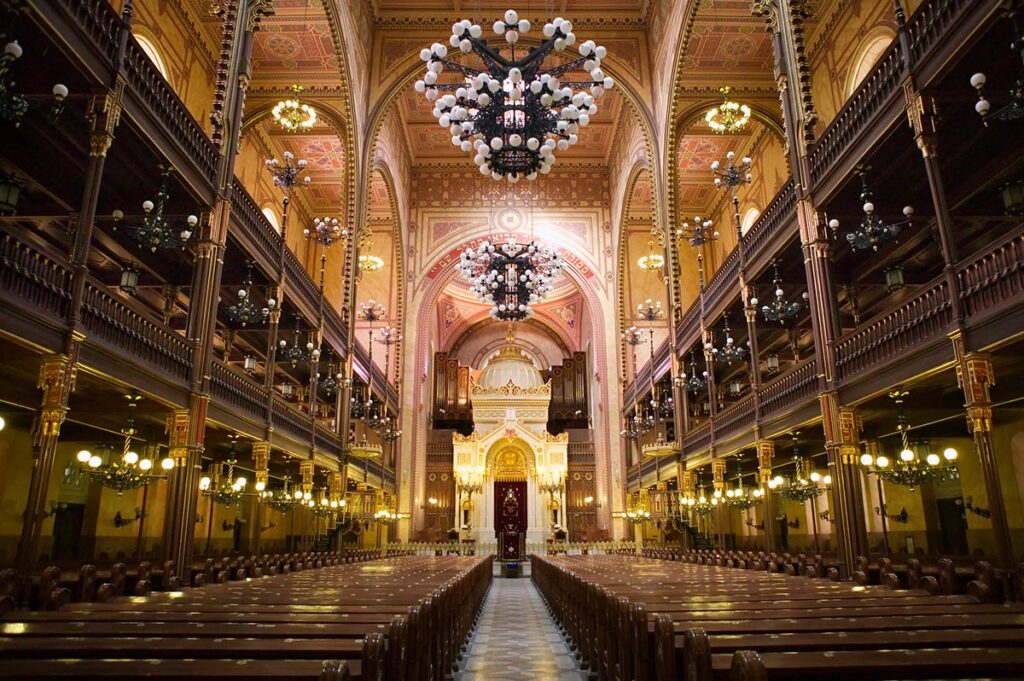
Aside from being a functioning synagogue, it also houses the Hungarian Jewish Museum and Archives, where you can learn about Hungary’s Jewish history.
The museum’s collection boasts Judaica objects, historical relics, and rare pre-Holocaust archives. Notably, in 1942, two Hungarian National Museum employees safeguarded precious items from the Jewish Museum by concealing them in the National Museum’s cellar. Thanks to their bravery, these artifacts continue to be displayed at the Hungarian Jewish Museum today.
Raoul Wallenberg Holocaust Memorial Park
Located in the Dohány Street Synagogue’s courtyard, the Raoul Wallenberg Holocaust Memorial Park is home to the Tree of Life memorial. The weeping willow, designed by artist Imre Varga, bears the names of hundreds of thousands of Hungarian Jews killed during the Holocaust on its leaves.
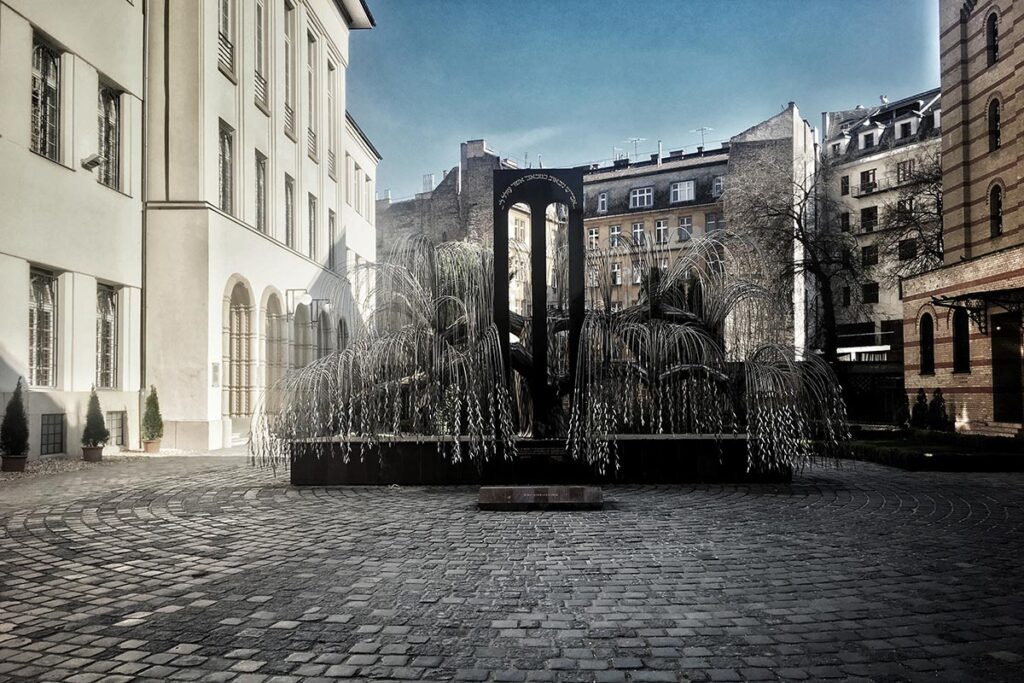
There, you will also find a memorial to Raoul Wallenberg — a Swedish diplomat who saved thousands of Jews in German-occupied Hungary during the Holocaust — and other “Righteous Among the Nations” who saved Hungarian Jews during World War II.
Theodor Herzl House
Theodor Herzl, the founder of political Zionism, was born and raised in Budapest. His life and legacy are commemorated in various parts of the city.
You can visit the Theodor Herzl House, located at Dohány Street 1, within the Dohány Street Synagogue complex. Although the original house where Herzl was born no longer stands, you can see the site where this iconic figure lived and visit the Hungarian Jewish Museum which has been set up in its place.
Statue of Theodor Herzl
Also near the Dohány Street Synagogue and Herzl’s birth site, you’ll find a hidden miniature statue of Herzl with his bike. It’s a quiet spot to reflect on Herzl’s vision for a Jewish state.
The tiny statue is part of a citywide artistic initiative by sculptor Mihály Kolodko. His series of whimsical bronze figures, located throughout Budapest, honor various figures who contributed significantly to the city’s history and heritage. See a map of all of Kolodko’s mini statues here.
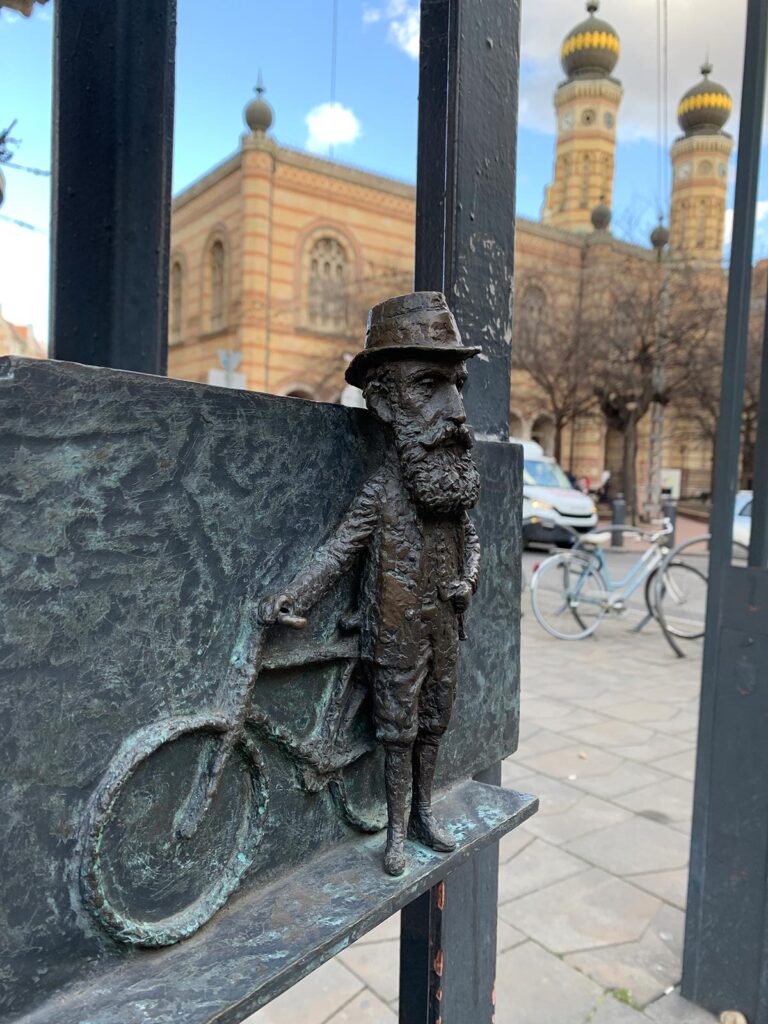
The Holocaust Memorial Center
Established by the Hungarian government and opened as a memorial and museum in 2004, the Holocaust Memorial Center is housed within the Pava Street Synagogue.
It is one of only six other institutions in the world established by states to commemorate the Holocaust. The center has permanent and temporary exhibitions, as well as a research center to find and add names of family members who perished during the Shoah.
Shoes on the Danube Bank
The Shoes on the Danube Bank is one of the most chilling memorials in Budapest. Located on the eastern bank of the Danube River, it pays tribute to the Jews who were killed by Hungarian Arrow Cross militiamen during World War II.
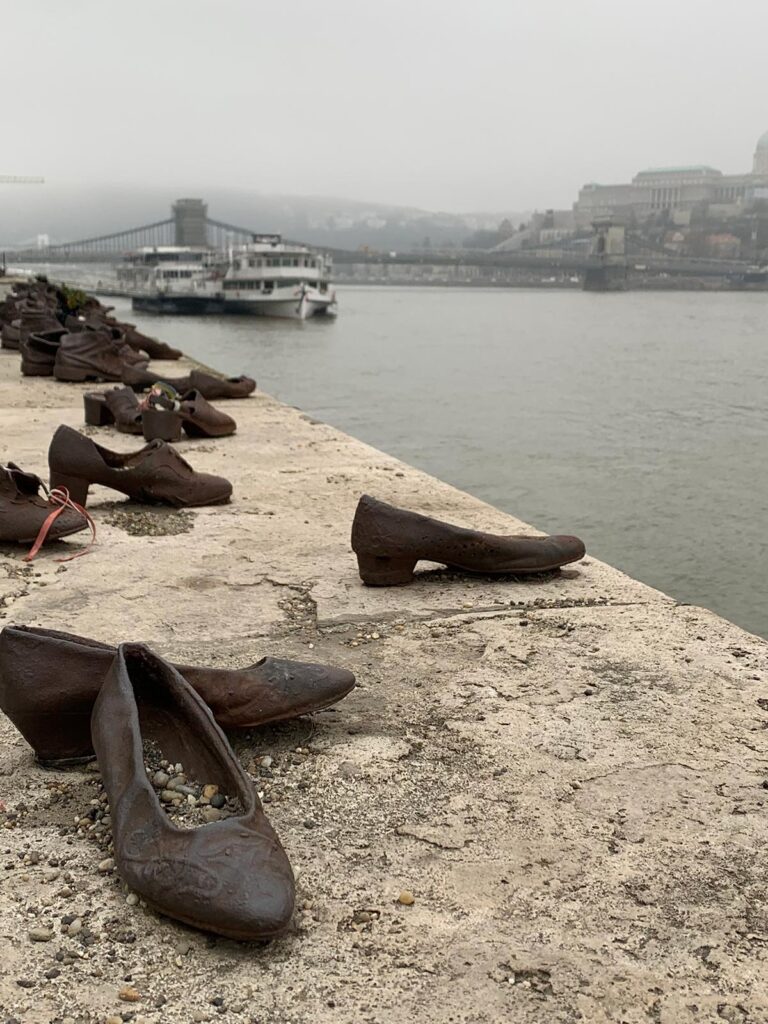
The memorial consists of 60 pairs of iron shoes, representing the shoes left behind by the victims. Created by film director Can Togay and sculptor Gyula Pauer, each pair of shoes was crafted to resemble the styles of the 1940s, adding a haunting realism to the memorial. Victims were ordered to remove their shoes before being shot at the edge of the water, as shoes were valuable commodities taken by the militiamen.
Carl Lutz Memorial
The Carl Lutz Memorial is a lesser-known but significant site. Carl Lutz was a Swiss diplomat who saved an estimated 62,000 Jews during the Holocaust. He issued protective letters to Hungarian Jews for emigration to Palestine, and set up safe houses for them around Budapest.
A 15-minute walk from the memorial, you can also visit the Glass House Memorial Museum. The Glass House was the building Lutz used to provide refuge for Jews during the Holocaust. Today, you can visit the site — dedicated to the memory of those who Lutz saved — and learn more about this unique tale of resistance and humanity during World War II.
Memorial for Victims of the German Occupation
For insights into ongoing Jewish discussions and debates about antisemitism in Budapest, visit the Memorial for Victims of the German Occupation in Freedom Square. Since it was erected in 2014, this monument has ignited controversy.
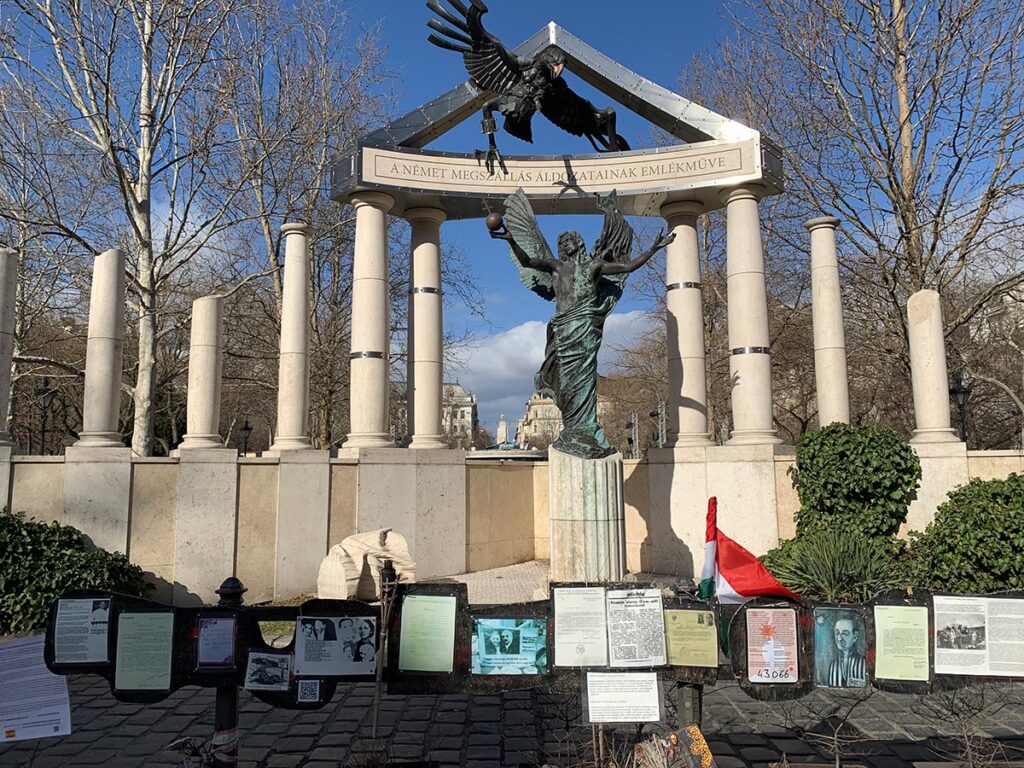
It portrays the Archangel Gabriel, representing Hungary, being attacked by a German imperial eagle, suggesting that Hungary was a victim during the Nazi occupation. Critics argue that this portrayal glosses over the active role played by both the Hungarian government and its citizens in the persecution and deportation of Jews during the Holocaust.
In response to the monument, a counter-memorial sprung up in front of it. Personal items and memorabilia left by the descendants of Hungarian Holocaust victims and survivors serve as a reminder of the atrocities committed.
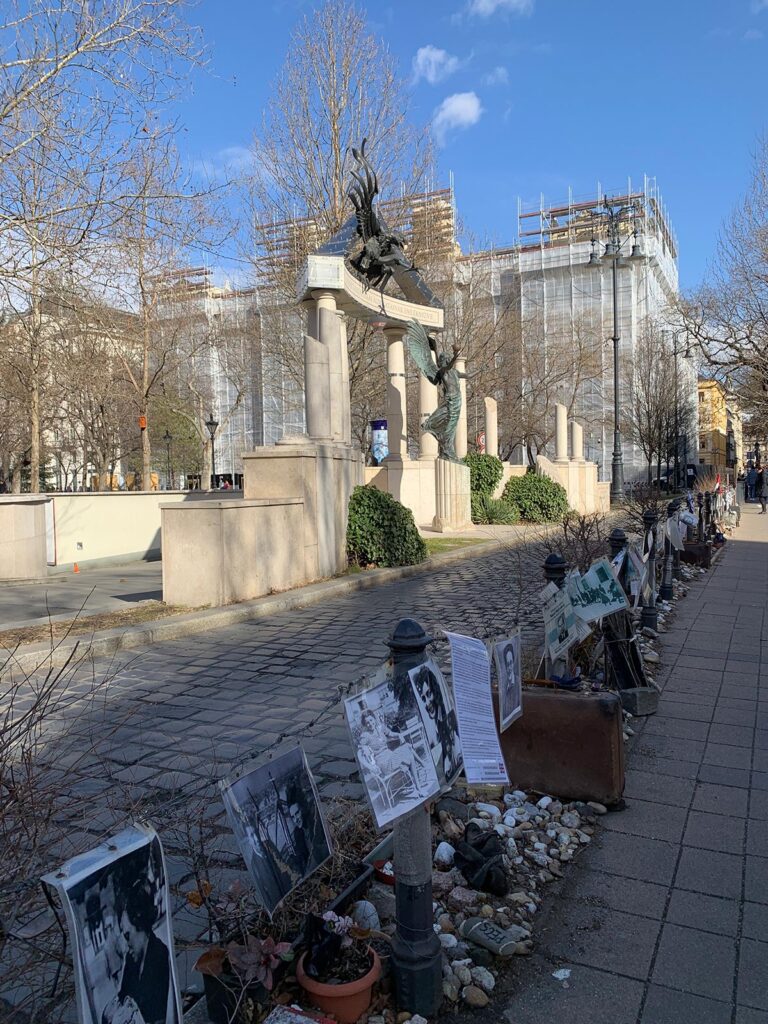
The site underscores the ongoing battle for historical truth, offering a unique perspective on Hungary’s collective memory and actions in the Holocaust.
What to do
Jewish Walking Tour
To explore Budapest’s Jewish heritage, consider taking a Jewish walking tour, guided by experts who offer deep insights into its history and culture.
There are both paid and free walking tours available, catering to a range of budgets and interests. Some tours focus on the city’s historic sites, while others delve into contemporary Jewish life in Budapest.
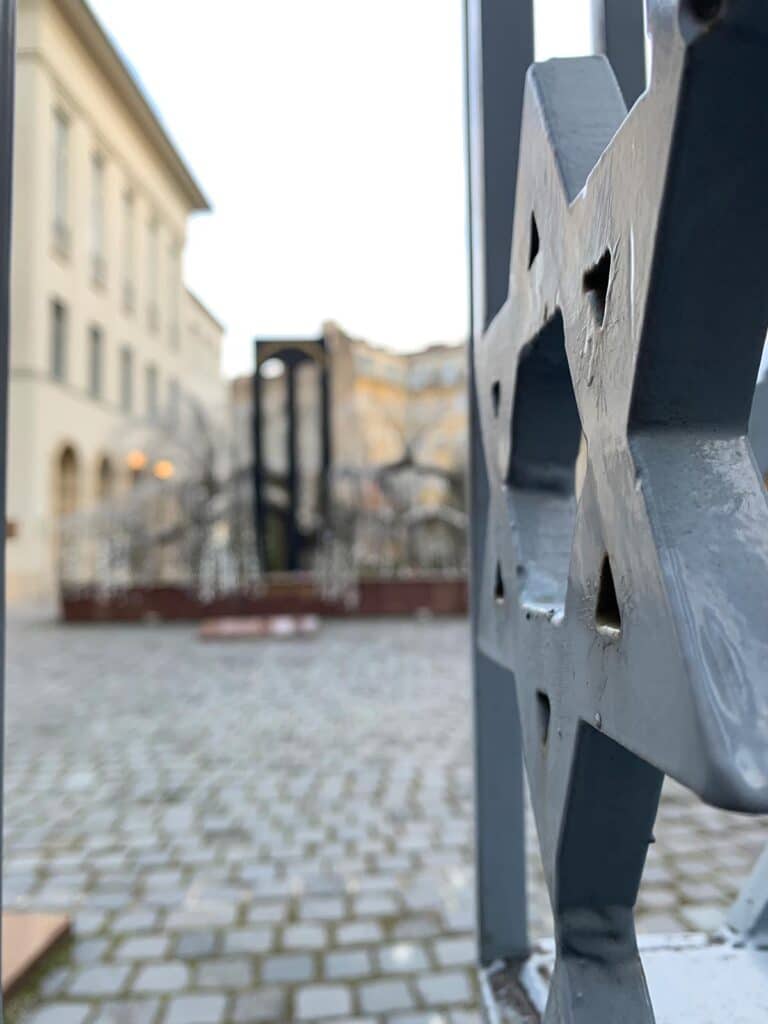
Jewish Summer Festival
One of the highlights of Budapest’s Jewish cultural calendar is the Jewish Summer Festival. Held annually in late August or early September, the festival takes place primarily in the Jewish Quarter. Over a week, its streets and squares transform into venues for concerts, exhibitions, and culinary events.
From klezmer music and contemporary Jewish cinema to traditional food and craft markets, the festival offers a range of experiences that cater to all ages and interests.
Some of the festival’s main venues include the Dohány Street Synagogue and the historic Goldmark Hall. The festival also extends to other synagogues and cultural institutions throughout the city.
How to spend Shabbat
The Chabad House of Budapest hosts weekly Shabbat meals and can assist with arranging your stay in Shabbat-friendly accommodations. Glatt-kosher meat restaurants Hanna and Carmel also host lively prepaid Shabbat meals.
You can attend Shabbat services at one of Budapest’s 20 active synagogues, including the Dohány Street Synagogue and the Kazinczy Street Synagogue.
Where to eat
Budapest’s Jewish Quarter is not only a historical area but also a gastronomic hub. Here, you can find kosher fare, contemporary Jewish cuisine and restaurants that reflect Budapest’s growing Israeli influence. Here are some of the popular spots.
The kosher scene
There are a few delicious kosher spots in Budapest. Hanna and Carmel are popular glatt-kosher meat restaurants. For dairy fare, you can visit Tel Aviv Cafe (glatt-kosher) or Kosher Deli Budapest.
A newer addition to Budapest’s growing kosher food scene, Kosher MeatUp, is Budapest’s first kosher fast food spot, offering hamburgers, shawarma or schnitzel. For a sweet treat, head to Frohlich Bakery & Cafe.
Traditional Jewish-Hungarian fare
For a taste of traditional Jewish-Hungarian cooking, check out Rosenstein, Kőleves, and Macesz Bistro.
Rosenstein Restaurant serves up the best of traditional Hungarian-Jewish cooking, including dishes like calf lung stew, matzah ball soup and flodni.
Kőleves Restaurant, housed in a 1851 building which was once a kosher butcher shop, pays homage to Budapest’s Jewish history by serving their modern twist on traditional Jewish-Hungarian dishes.
Macesz Bistro creatively reimagines classic Jewish-Hungarian dishes, combining traditional flavors with contemporary culinary techniques. Here, you’ll find dishes like vegetarian matzah lasagne, cholent, and veal paprikash.
Israeli eats
For a taste of Israel in Budapest visit Mazel Tov, known for its vibrant atmosphere, or Hummus Bar for its laid-back vibes. Both restaurants serve up delicious Israeli dishes like shakshuka, pita sandwiches and hummus.
When will you be visiting Budapest? Let us know on Instagram, Twitter, and TikTok!


